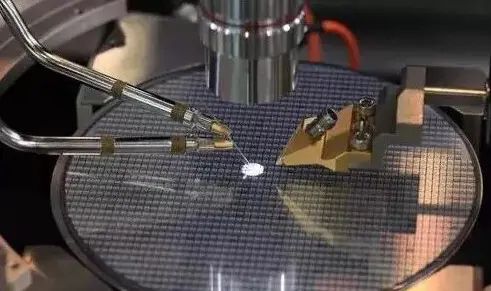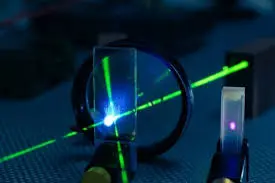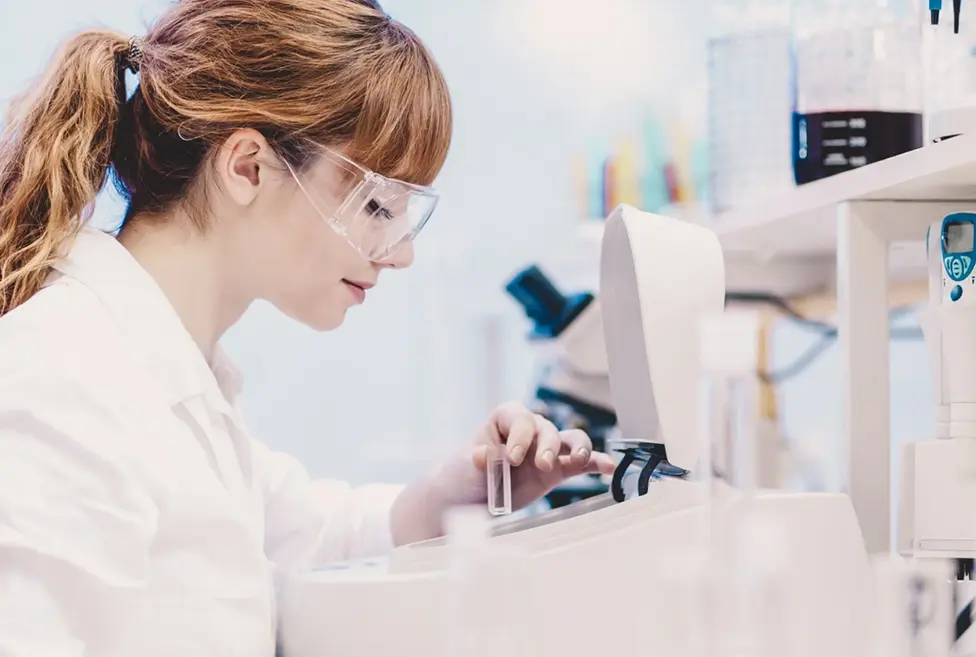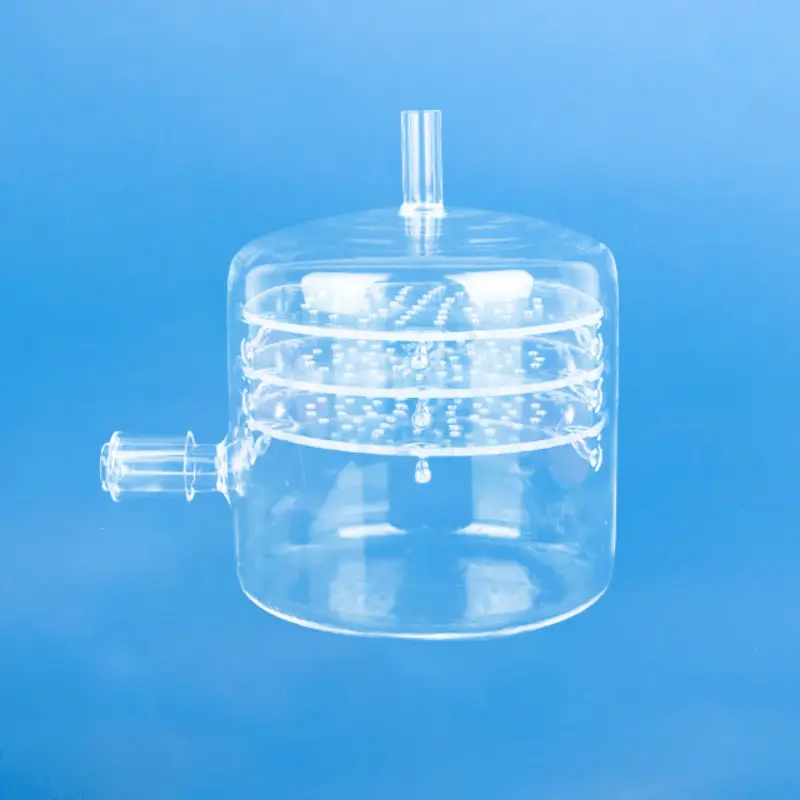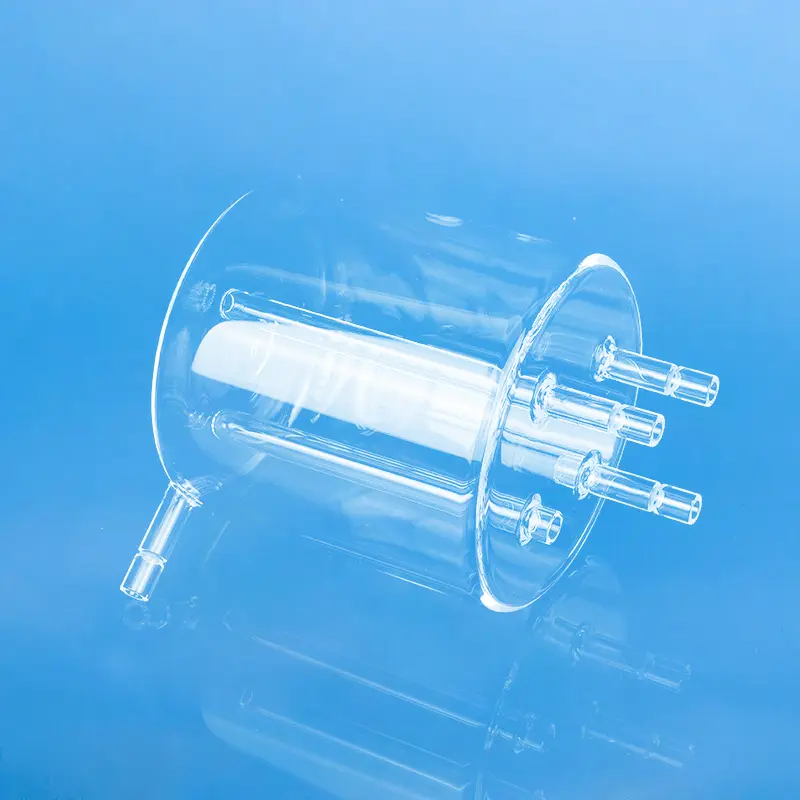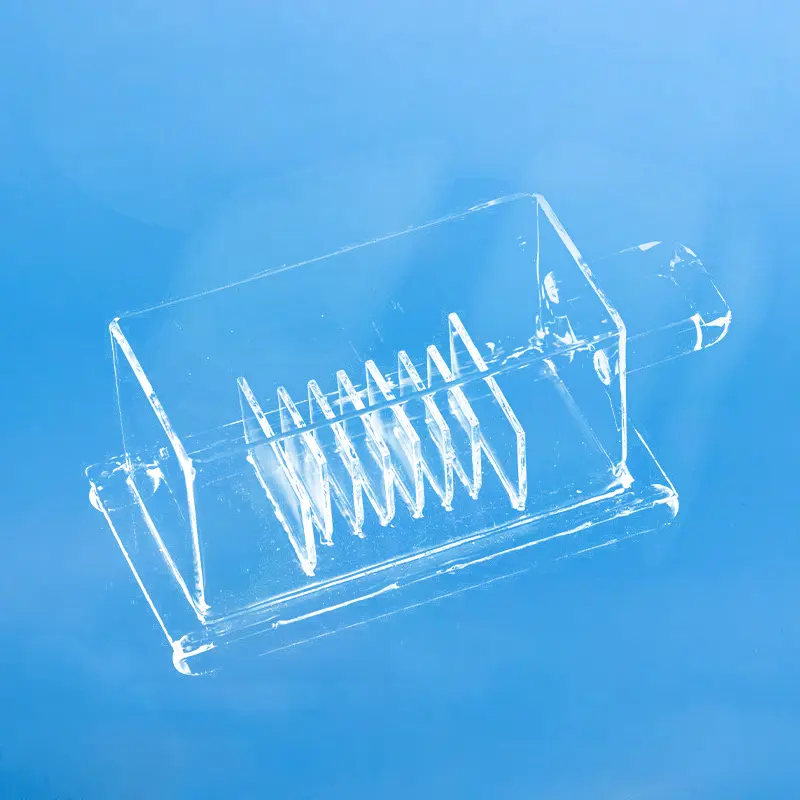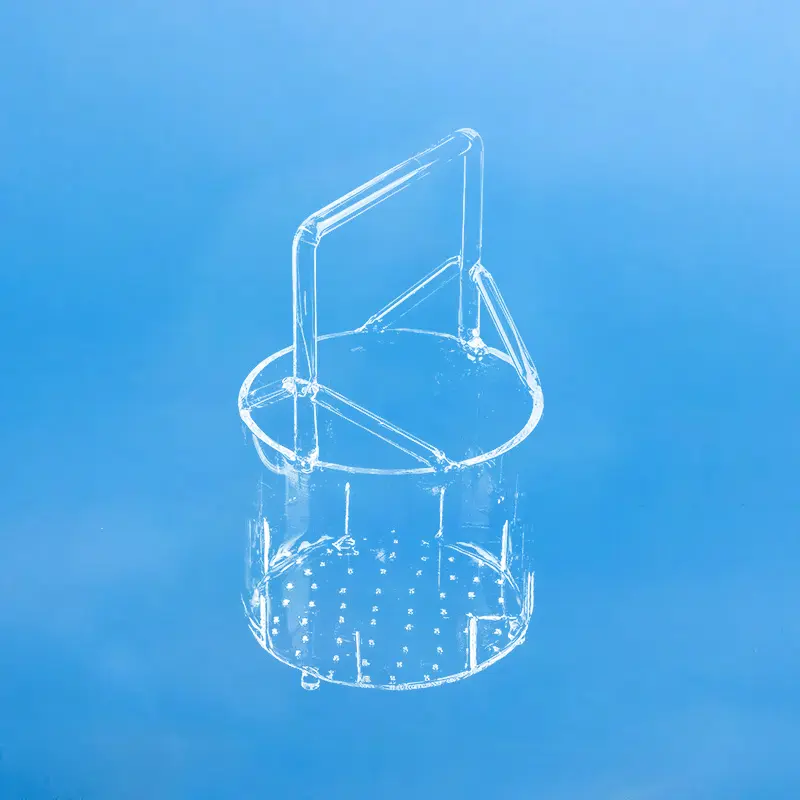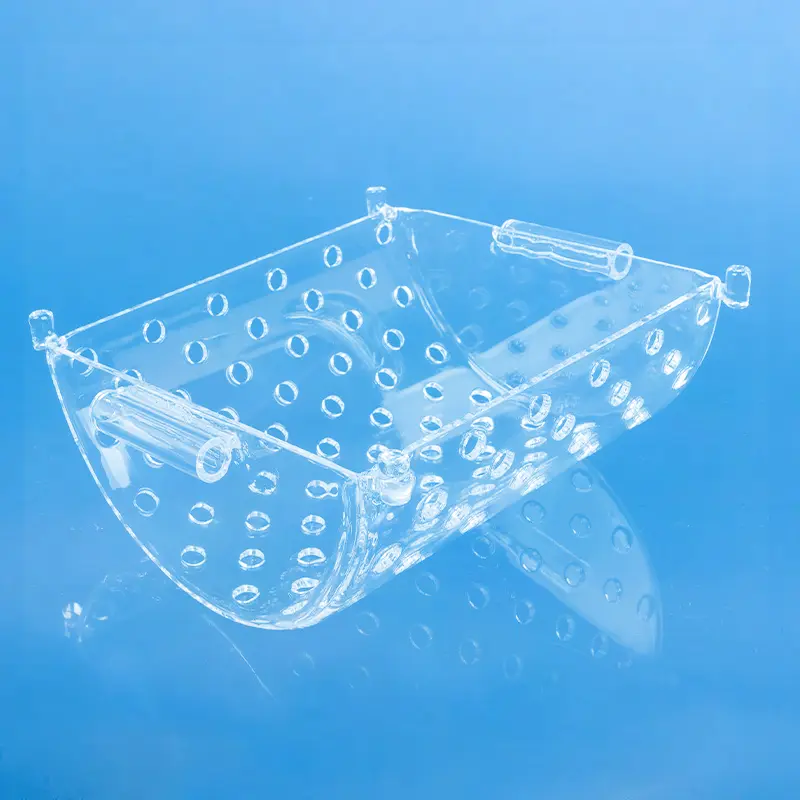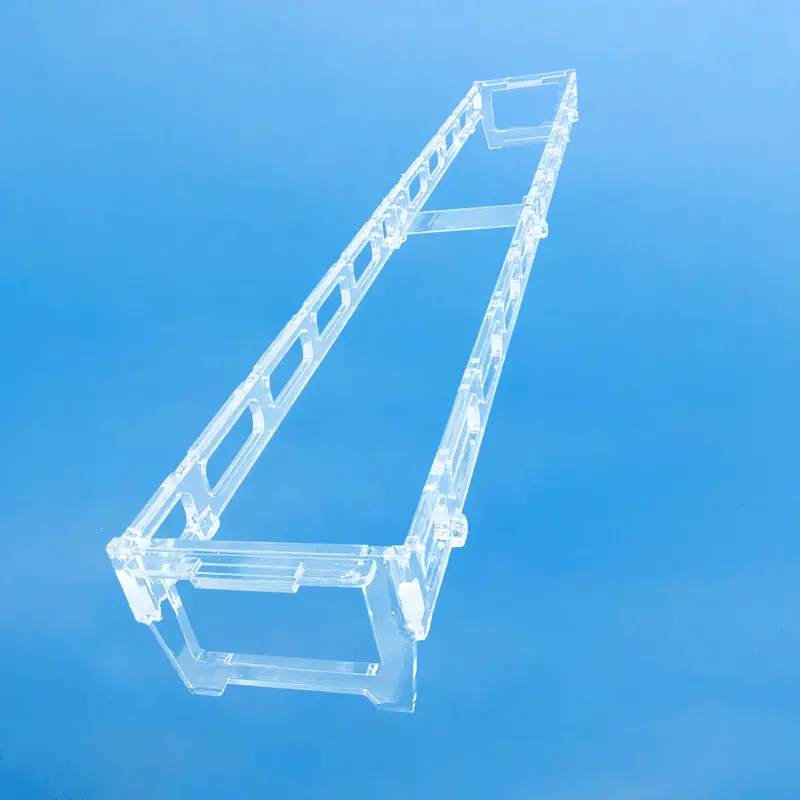Unsere hochreinen, kundenspezifischen Quarz-Gaswäscher und Gaszuführungsgefäße sind präzisionsgefertigte Quarzglasbauteile für kritische Anwendungen. Ideal für CVD/MOCVD-Prekursorzuführung, Halbleiterbearbeitung und den Umgang mit korrosiven/hochtemperaturchemikalien, gewährleisten sie präzise Flüssigkeits-/Gassteuerung. Sie erfüllen anspruchsvolle Industrie- und Forschungsanforderungen dank ihrer außergewöhnlichen Reinheit und thermischen Stabilität.
| Eigenschaftsinhalt | Eigenschaftswerte |
|---|---|
| SiO2 | 99.99% |
| Dichte | 2,2×10³ kg/cm³ |
| Härte | Mohs-Härte 5,5 - 6,5; Knoop-Härte 570 (bei 100 g Prüflast) |
| Zugfestigkeit | 4,8 × 10⁷ Pa (48 N/mm² bzw. 48 MPa); 7.000 psi |
| Druckfestigkeit | >1.1×10⁹ Pa (160,000 psi) |
| Wärmeausdehnungskoeffizient | 5.5×10⁻⁷ cm/cm·°C (20°C-320°C) |
| Wärmeleitfähigkeit | 1,4 W/m-°C |
| Spezifische Wärme | 670 J/kg-°C |
| Erweichungspunkt | 1730°C (3146°F) |
| Transformationspunkt | 1210°C (2210°F) |
| Spannungspunkt | 1120°C (2048°F) |
| Arbeitstemperatur | 1200°C (2192°F) |
| Elektrischer Widerstand | 7×10⁷ Ohm cm (350°C) |
| Größe | Kundenspezifisch |
| Logo | Personalisierung mit Logo |
Hohe Reinheit
Quarz-Quellflaschen werden aus hochreinem Quarzglas gefertigt, wodurch die chemische Stabilität und Reinheit des Behälters gewährleistet und somit Reaktionen mit oder Kontaminationen der gelagerten Materialien verhindert werden.
Hohe Temperaturbeständigkeit
Quarzglas besitzt eine ausgezeichnete Hochtemperaturbeständigkeit, wodurch es auch bei erhöhten Temperaturen langfristig ohne Verformung oder Beschädigung eingesetzt werden kann.
Korrosionsbeständigkeit
Quarzglas weist eine hervorragende Korrosionsbeständigkeit gegenüber einer Vielzahl chemischer Reagenzien auf, wodurch es sich ideal zur Lagerung und zum Transport verschiedener korrosiver Substanzen eignet.
Leichte Reinigung
Die glatte Oberfläche von Quarzglas verhindert das Anhaften von Schmutz und erleichtert somit die Reinigung und Wartung.
Anwendungsszenario
Halbleiterindustrie
Halbleitermaterial- und Bauelementefertigung: Quarz-Source-Flaschen sind unverzichtbare Materialien in der Halbleiterfertigung und werden häufig in Tiegeln, Schiffchen, Ofenkernrohren und Glasglocken für das Züchten von Germanium- und Silizium-Einkristallen verwendet. Diese Komponenten müssen hohen Temperaturen und korrosiven Umgebungen standhalten, wodurch die Hochtemperatur- und Korrosionsbeständigkeit von Quarz-Source-Flaschen ideal ist.
Reinigung und Diffusion: In Halbleiterreinigungs- und -diffusionsprozessen werden Quarz-Source-Flaschen auch häufig als Reinigungsbehälter und Diffusionstuben verwendet, um Prozessstabilität und Präzision zu gewährleisten.
Optische Technologie
Optische Instrumente und Geräte: Aufgrund ihrer hervorragenden optischen Eigenschaften werden Quarz-Source-Flaschen vielfältig bei der Herstellung von Prismen und Linsen für optische Instrumente wie Ultraschall-Verzögerungsleitungen in Radargeräten, Infrarot-Verfolgungs- und Entfernungsmessgeräten, Infrarotkameras, Kommunikationsgeräten, Spektrographen und Spektralphotometern eingesetzt.
Große Astronomische Teleskope: Quarzglas wird aufgrund seiner hohen Transparenz und seines geringen Wärmeausdehnungskoeffizienten auch bei der Herstellung von Reflexionsfenstern für große astronomische Teleskope eingesetzt, um die Beobachtungspräzision und Stabilität des Teleskops zu erhöhen.
Labor und Forschung
Laborbehälter: Aufgrund ihrer chemischen Beständigkeit und Hochtemperaturbeständigkeit werden Quarz-Source-Flaschen oft als Laborbehälter verwendet, beispielsweise zum Sammeln und Verarbeiten chemischer Abfälle.
Forschungsausrüstung: In Forschungsumgebungen werden Quarz-Source-Flaschen auch zur Herstellung verschiedener Präzisionskomponenten für Forschungsausrüstung verwendet, um den Anforderungen wissenschaftlicher Studien gerecht zu werden.
Quarz-Source-Flaschen weisen einen Siliziumdioxid (SiO2)-Gehalt von bis zu 99,995 % auf, wodurch Risiken im Zusammenhang mit Glasinhomogenitäten (einschließlich Schichtbildung) und der Auslaugung problematischer Metallionen eliminiert werden.
Quartz source bottles exhibit extremely high stability at high temperatures and do not easily deform. Their low thermal expansion coefficient and excellent thermal shock resistance allow them to maintain their shape and structural integrity under drastic temperature changes.
Sicherstellung der experimentellen Genauigkeit: Quarz-Source-Flaschen können bei Temperaturen von bis zu 1100 °C stabil bleiben. Dies bedeutet, dass Quarz-Source-Flaschen in Hochtemperaturexperimenten als zuverlässige Behälter dienen und so gewährleisten, dass die Genauigkeit der Versuchsergebnisse nicht durch thermische Verformung oder Zersetzung des Behälters beeinträchtigt wird.
Erhöhung der experimentellen Sicherheit Quarz-Source-Flaschen besitzen eine hervorragende Temperaturwechselbeständigkeit, was bedeutet, dass sie selbst bei schnellen Temperaturänderungen nicht zu Rissbildung neigen. Dies reduziert Sicherheitsrisiken bei Hochtemperaturexperimenten erheblich und schützt Laborpersonal und Ausrüstung.
Häufig gestellte Fragen
Wir sind auf die durchgängige Fertigung von hochreinen Quarzglaskomponenten spezialisiert. Unsere Kernproduktlinien umfassen:
Quarzrohre & -stäbe: Eine große Auswahl an Durchmessern und Spezifikationen.
Quarzplatten & -scheiben: Präzisionsgeschnitten und poliert für optische und industrielle Anwendungen.
Quarzlaborglas: Ein komplettes Sortiment an Standard- und kundenspezifischen Glasgeräten, einschließlich Bechergläsern, Kolben und Booten.
Halbleiterquarz: Hochreine Komponenten wie Prozessrohre und Träger für die Halbleiterfertigung.
Kundenspezifische Fertigungskomponenten: Wir können komplexe Teile nach Ihren einzigartigen Designs und Spezifikationen fertigen.
Ja. Kundenspezifische Fertigung ist das Herzstück unseres Geschäfts. Mit über einem Jahrzehnt spezialisierter Erfahrung arbeiten wir eng mit Unternehmen zusammen, um erstklassige OEM/ODM-Dienstleistungen anzubieten. Unsere Kompetenzen umfassen Schweißen, Schleifen, Bohren, Polieren, Biegen und weitere Präzisionsbearbeitungstechniken, um Komponenten zu fertigen, die exakt Ihren Anforderungen entsprechen.
Qualität ist in unserem Herstellungsprozess von größter Bedeutung. Wir sind ein ISO 9001:2015 zertifizierter Hersteller, der sicherstellt, dass unsere Prozesse internationale Qualitätsmanagementstandards erfüllen.Unsere Produkte durchlaufen zudem rigorose SGS-Prüfungen hinsichtlich Reinheit und Leistung. Wir verwenden hochreine Rohmaterialien (bis zu 99,998% SiO2), um Quarzglas- und Kieselglasprodukte mit außergewöhnlicher thermischer Stabilität, hoher Temperaturbeständigkeit und chemischer Inertheit herzustellen.
Wir haben unsere Prozesse maximal effizient gestaltet:
Senden Sie Ihre Angebotsanfrage (RFQ): Senden Sie uns Ihre technischen Zeichnungen, Spezifikationen und Anforderungen über unser Kontaktformular auf der Website oder per E-Mail.
Schnelle Reaktion: Sie können eine erste Antwort innerhalb weniger Minuten und eine detaillierte Kommunikation innerhalb einer halben Stunde erwarten.
Design & Angebot: Wir liefern Ihnen innerhalb von 24 Stunden einen detaillierten Designvorschlag und ein wettbewerbsfähiges Angebot.
Prototypenentwicklung & Produktion: Nach Freigabe gehen wir zügig von der Prototypenfertigung zur Serienproduktion über, um Ihre Fristen einzuhalten.
Eine Partnerschaft mit Aoxin Quartz bietet mehrere entscheidende Vorteile:
Nachgewiesene Expertise: Mit über 10 Jahren Branchenerfahrung verfügen wir über das technische Fachwissen, um komplexe Herausforderungen zu meistern.
One-Stop Solution: We manage the entire production process, from sourcing high-purity raw materials to fabricating and finishing complex components.
Wettbewerbsfähiger Wert: Als Standort in einem wichtigen Quarzproduktionszentrum nutzen wir eine effiziente Lieferkette und fortschrittliche Fertigung, um außergewöhnliche Qualität zu einem wettbewerbsfähigen Preis anzubieten.
Dedicated Partnership: Over 90% of our clients become long-term partners. We are committed to your success through responsive service, reliable quality, and innovative solutions.


